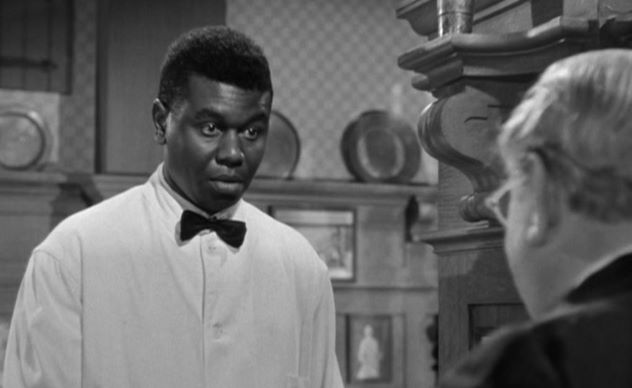 Creepy
Creepy  Creepy
Creepy  Movies and TV
Movies and TV 10 Movies That Get Elite Jobs Right, According to Experts
 Weird Stuff
Weird Stuff 10 Times Real Laws Were Based on Bizarre Hypotheticals
 Animals
Animals 10 Inspiring Tales of Horses Being Human
 Mysteries
Mysteries Top 10 Haunting Facts About the Ghost Ship MV Alta
 History
History 10 Surprising Stories About the Texas Rangers
 Humans
Humans 10 Philosophers Who Were Driven Mad by Their Own Theories
 Miscellaneous
Miscellaneous 10 Video-Game-Worthy Weapons and Armors from History
 Weird Stuff
Weird Stuff 10 Psychics Who Accurately Predicted Wartime Events
 The Arts
The Arts 10 Pieces of Art Inspired by a Broken Heart
 Creepy
Creepy 10 Death Superstitions That Will Give You the Creeps
 Movies and TV
Movies and TV 10 Movies That Get Elite Jobs Right, According to Experts
 Weird Stuff
Weird Stuff 10 Times Real Laws Were Based on Bizarre Hypotheticals
Who's Behind Listverse?

Jamie Frater
Head Editor
Jamie founded Listverse due to an insatiable desire to share fascinating, obscure, and bizarre facts. He has been a guest speaker on numerous national radio and television stations and is a five time published author.
More About Us Animals
Animals 10 Inspiring Tales of Horses Being Human
 Mysteries
Mysteries Top 10 Haunting Facts About the Ghost Ship MV Alta
 History
History 10 Surprising Stories About the Texas Rangers
 Humans
Humans 10 Philosophers Who Were Driven Mad by Their Own Theories
 Miscellaneous
Miscellaneous 10 Video-Game-Worthy Weapons and Armors from History
 Weird Stuff
Weird Stuff 10 Psychics Who Accurately Predicted Wartime Events
 The Arts
The Arts 10 Pieces of Art Inspired by a Broken Heart
10 Black Actors Who Shattered Stereotypes in Classic Hollywood
Today, some of the most bankable stars in Hollywood are African-American actors, such as Will Smith, Denzel Washington, or “the voice” Morgan Freeman, whose talent might have in all likelihood been denied in classic Hollywood. Hattie McDaniel was the first African-American actress to win a competitive Oscar. But sadly for her and many of her contemporaries, the best roles available were those that depicted black servants or slaves.
Nonetheless, the notion that African-Americans were denied roles as empowered characters of complexity and intellect during this period was occasionally challenged. Consider this cross-section of performances from 1929 until the 1960s by a talented sampling of African-American actors, of whom many are sadly forgotten.
Related: 10 Golden Hollywood Scandals That Were Covered Up
10 Everett Brown
Texas native Everett Brown (1902–1953) was cast in forty movies in a career that spanned from the silent era until the early 1950s. He was largely typecast in minor stereotypical roles, and often his screen appearances went uncredited. In the classic 1939 film Gone with the Wind, his performance as “Big Sam,” though memorable, was primarily that of a caricatured black servant, except for one scene.
In a suspenseful moment in which the film’s protagonist Scarlett O’Hara drives a buggy alone through a “shantytown,” she is stopped and attacked by a vagrant and his black partner. Hearing Scarlett scream, Big Sam runs to her rescue and knocks out her assailant. This scene probably goes unnoticed by most contemporary audiences.
However, just over two decades removed from the heavyweight championship reign of black fighter Jack Johnson, it was significant. For cameramen at that time were told not to film the titlist knocking a white contender out. Along with including the expletive “damn” in the film’s finale, this was perhaps another example of producer David O. Selznick circumventing censors and the Motion Picture Production Code.[1]
9 Emmett Smith

Perhaps the least remembered of the black actors on this list, Emmett Smith never achieved the status of a star. However, if you look closely, you’ll find him portraying a bartender in the John Wayne action-adventure Hatari! (1962). Smith also played small parts in classic motion pictures ranging from Sunset Blvd. (1950) to Stanley and Livingstone (1939) and To Have and Have Not (1944).
But his most memorable screen moment was arguably a brief one in the 1945 holiday favorite Christmas in Connecticut. Playing what appears to be a stereotypical waiter named Sam in a Hungarian restaurant, Smith is consulted by his frazzled boss for the translation of an English word he doesn’t understand: “catastrophe.” In a rare moment depicting a black man of intellect and sophistication, Sam defines the word while breaking down its meaning and Greek origin. Perhaps, once again, this is a moment that flies over the heads of modern viewers. But clearly, director Peter Godfrey chose to include this scene to convey a subtle but clear point regarding stereotypes.[2]
8 Esther Brown
Talk about making a lasting impact on the silver screen in spite of appearing in only one scene in only one movie with a mere 17 seconds of dialogue, but UCLA student Esther Brown did just that. Her fifteen minutes of fame came when Cecil B. De Mille cast her as the Ethiopian Princess Tharbis in his epic production of The Ten Commandments in 1956. Her memorable scene in which she placed a precious emerald in the hands of Charlton Heston’s Moses elicited a jealous response from Anne Baxter’s Princess Nefretiri, who refers to Brown’s character as “such a beautiful enemy.”
The implied romance between Moses and Princess Tharbis is perhaps in some ways more shocking than Heston’s interracial kiss he shared with African-American co-star Rosalind Cash in the 1971 film The Omega Man. The Ten Commandments was produced fifteen years earlier and over a decade before the Supreme Court struck down anti-miscegenation laws in the U.S. Sadly, this would be Brown’s only film role despite the beauty and charisma she is remembered for in a movie that is still broadcast on network television annually during the Easter and Passover seasons.[3]
7 James Edwards
In many respects, Indiana native and Northwestern University alum James Edwards (1918–1970) was the precursor to Sidney Poitier, being one of the first black actors to earn critical acclaim. Edwards was commissioned as a first lieutenant in the United States Army during World War II. His combat experience served him well in an acting career in which he was typecast in numerous soldier roles. Notably, he played a blinded veteran in support of Arthur Kennedy in the latter’s Academy Award-nominated performance in Bright Victory (1951). Later, Edwards starred in Battle Hymn (1957) and Patton (1970), in which he portrayed the colorful general’s longtime personal valet.
But arguably, his best-known performance was in the 1949 production of Home of the Brave. Portraying a paralyzed war veteran battling emotional wounds from combat and a lifetime of racial prejudice, Edwards made a memorable impression on post-World War II audiences. The adapted screenplay by Carl Foreman would later receive the Writers Guild’s Robert Meltzer Award for the “Screenplay Dealing Most Ably with Problems of the American Scene.”[4]
6 Fredi Washington
Stage actress and dancer Fredi Washington (1903–1994) was chosen by director John M. Stahl to play the conflicted Peola Johnson, the light-skinned daughter of a black mother who chooses to pass as white, in the 1934 original film version of Imitation of Life. In a movie that pushed many boundaries in the depiction of race and the societal role of women, Time magazine listed it as one of “The 25 Most Important Films on Race” in 2007.
The movie’s depiction of Washington’s character rejecting her loving African-American mother appalled many, particularly black audiences. Still, the authenticity of Washington’s performance resonated with many facing similar challenges in a country in which segregation was still legal and miscegenation banned. Although Washington was of African descent and self-identified as a black woman, the Douglas Sirk remake of Imitation of Life (1959) would later cast white actress Susan Kohner in the same role with a different name, Sarah Jane. Kohner’s performance would win her the 1959 Golden Globe for Best Supporting Actress.[5]
5 Canada Lee
One of the earliest African-American actors to secure leading roles in film and on stage, Canada Lee (1907–1952) was also a professional boxer and civil rights activist. His first big break occurred when Orson Welles cast Lee as Banquo in his 1936 production of Macbeth, which featured an all African-American cast. A box office sensation, it opened doors for Lee both on stage and in Hollywood.
Ultimately, he landed the role of ship’s steward Joe Spencer in the classic Alfred Hitchcock film Lifeboat (1944). Although contemporary critics criticized the part for being stereotypical and “tokenistic,” Lee’s character was notable for exhibiting heroism and compassion. When Nazi sailor Walter Slezak is rescued from drowning in the North Atlantic, only Lee’s character Joe is unwilling to join the mob in killing him. Later, it is Joe alone who disarms the villain. Lee would also give strong performances in the film noir boxing classic Body and Soul (1947) and the anti-apartheid drama Cry, the Beloved Country (1951), despite being blacklisted for alleged communist affiliations. One year after the latter film’s release, Lee died of a heart attack at the age of 45.[6]
4 Nina Mae McKinney
Nina Mae McKinney (1912–1967) was not only one of the first African-American film stars in Hollywood, but she was also one of the first black international celebrities, later achieving fame appearing on early television programs in the UK. But what ignited McKinney’s career was her scene-stealing turn as the temptress Chick in King Vidor’s 1929 landmark musical Hallelujah! Not only was the movie groundbreaking as one of the first sound films shot almost entirely on location in Arkansas and Memphis, Tennessee, but also because of Vidor’s decision to shoot the first musical with an all-black cast.
McKinney’s striking beauty led the international press to nickname her “The Black Garbo.” Certainly, her performance in Hallelujah! was a departure from the typical typecasting of black actresses. So provocative was McKinney’s character that movie critic Donald Bogle credited her as the silver screen’s “first black love goddess.” At the very least, she set the standard for later femme fatales. In retrospect, maybe Jean Harlow was “The White Nina Mae McKinney.”[7]
3 Woody Strode
If there was ever a classic Hollywood actor of African descent who projected the strong, silent “tough guy” persona, it was Woody Strode (1914–1994). Long before emerging as a Western sidekick to John Wayne in The Man Who Shot Liberty Valance (1962) and as the king of Ethiopia in The Ten Commandments (1956), Strode was a world-class decathlete and one of the first African Americans to play in the NFL.
With his imposing, muscular physique and striking screen presence, John Ford would cast him as the title character in his 1960 film Sergeant Rutledge (1960). But perhaps no Strode performance is more memorable than his portrayal of the gladiator Draba later that year opposite Kirk Douglas in Spartacus (1960). In a pivotal scene, Strode’s character defeats Douglas in a battle to the death. But rather than kill his opponent, Strode hurls his trident at the patrician military commander Crassus, played by Sir Laurence Olivier, who pays for the fight. When his defiant act results in his death, the other white gladiators are inspired to revolt against Rome. Despite limited dialogue, Strode was unforgettable in the film. And 35 years later, Sheriff Woody in Toy Story was named in his honor.[8]
2 Juano Hernández
African-Latino and Puerto Rican native Juano Hernández’s (1896–1970) prolific acting career began during the silent era and lasted until 1970 when he was cast with another groundbreaking black actor, Sidney Poitier, in They Call Me Mr. Tibbs! Hernández starred in many supporting roles in A-list films, such as Sergeant Rutledge (1960), portraying a buffalo soldier cavalryman. A decade earlier, he portrayed the “father figure” to an aspiring trumpeter played by Kirk Douglas in Young Man with a Horn (1950). Without question, the depiction of a black man mentoring a white boy was a barrier-breaking moment for a classic Hollywood film.
But even more startling was Hernández’s performance as Lucas Beauchamp, a poor Mississippi farmer unjustly accused of the murder of a white man, in Clarence Brown’s Intruder in the Dust (1949) based on the William Faulkner novel. In a pivotal flashback scene, Hernandez proudly walks into a general store and fearlessly refuses to be intimidated by a white man who attempts to provoke him. Film historian Donald Bogle has written that Hernández’s “performance and extraordinary presence” in the film still ranks “above that of almost any other black actor to appear in an American movie.”[9]
1 Sidney Poitier
Arguably the most accomplished black actor in the history of cinema, the American-born Bahamian actor Sidney Poitier (1927–2022) won the Academy Award for Best Actor in the acclaimed 1963 film Lilies of the Field. In a film career that has spanned over six decades, Poitier has been nominated for three Academy Awards and ten Golden Globes in a filmography that includes a string of classic movies, including The Defiant Ones (1958) and In the Heat of the Night (1967).
But this cinematic legend’s career would have never taken off had it not been for his breakout role as Dr. Luther Brooks in Joseph Mankiewicz’s 1950 film No Way Out. Boasting an Oscar-nominated screenplay, Poitier plays a young idealistic doctor forced to treat a wounded criminal who later dies under his care. His brother, played by a villainous Richard Widmark, blames the young doctor for the death. So controversial was it that in 1962, NBC deemed it “too risky” for broadcast on its weekly Sunday Night at the Movies. Nonetheless, for Poitier, it launched one of the great film careers for an actor who defined the black leading man in Hollywood.[10]








